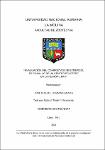Mostrar el registro sencillo del ítem
Evaluación del compostaje de estiércol de caballo de un centro ecuestre en la región Lima
| dc.contributor.advisor | Morón Barraza, Jonathan Alejandro | |
| dc.contributor.advisor | Baldeón Quispe, Wilfredo Celestino | |
| dc.contributor.author | Guzmán Anaya, José Miguel | |
| dc.date.accessioned | 2021-09-14T21:36:14Z | |
| dc.date.available | 2021-09-14T21:36:14Z | |
| dc.date.issued | 2021 | |
| dc.identifier.uri | https://hdl.handle.net/20.500.12996/4921 | |
| dc.description | Universidad Nacional Agraria La Molina. Facultad de Zootecnia. Departamento Académico de Producción Animal | es_PE |
| dc.description.abstract | El presente trabajo tuvo como objetivo determinar el grado de estabilidad del compost de estiércol equino. Se evaluaron tres tratamientos con diferentes proporciones de estiércol equino y residuos vegetales de jardinería, procedentes ambos de la Universidad Nacional Agraria La Molina (Lima, Perú). El método de compostaje empleado fue un sistema abierto de pilas con aireación mediante volteo manual durante 90 días haciendo volteos y tomando muestras cada dos semanas. El Tratamiento 1 alcanzó altos valores de temperatura mientras que el Tratamiento 2 es el que presenta menores valores: 44.07°C y 56.53°C. La humedad se estabilizó a partir del día 60 siendo el Tratamiento 1 el que finaliza el proceso con el valor más alto: 51.8 por ciento mientras el Tratamiento 3 es el que menor valor obtuvo: 51.28 por ciento. El Tratamiento 1 es el que finalizó más cerca a la neutralidad con un pH de 7.57. La conductividad eléctrica no presenta diferencias significativas finalizando los 3 tratamientos con un promedio de 0.20 ds/m. El efecto de la fase termófila fue eficiente para la higienización del material compostado encontrándose para los tres tratamientos en promedio 3.33 NMP/g coliformes fecales y 0 NMP/4g huevos de helmintos. Finalmente, la acumulación de nitrógeno total y el resultado de la relación C/N cercano al valor 11 al día 90 fueron indicativos del cumplimiento con las normas técnicas citadas. Se concluye que las proporciones evaluadas para compostaje de estiércol de equino son viables bajo los estándares de normas internacionales. | es_PE |
| dc.description.abstract | The objective of the present work was to determine the degree of stability of equine manure compost. Three treatments were evaluated with different proportions of horse manure and vegetable garden waste, both from the National Agrarian University La Molina (Lima, Peru). The composting method used was an open windrow system with aeration by manual turning for 90 days, turning and sampling every two weeks. Treatment 1 reached high temperature values while Treatment 2 is the one with the lowest values: 44.07°C and 56.53°C. Moisture stabilized from day 60 onwards, with Treatment 1 ending the process with the highest value: 51.8 percent, while Treatment 3 was the lowest: 51.28 percent. Treatment 1 is the one that ended the process closer to neutrality with a pH of 7.57. The electrical conductivity did not show significant differences, with the 3 treatments ending with an average of 0.20 ds/m. The effect of the thermophilic phase was efficient for the sanitization of the composted material, with an average of 3.33 NMP/g fecal coliforms and 0 NMP/4g helminth eggs for the three treatments. Finally, the accumulation of total nitrogen and the result of the C/N ratio close to value 11 at day 90 were indicative of compliance with the technical standards cited. It is concluded that the proportions evaluated for equine manure composting are viable under the standards of international norms. | en_US |
| dc.format | application/pdf | en_US |
| dc.language.iso | spa | es_PE |
| dc.publisher | Universidad Nacional Agraria La Molina | es_PE |
| dc.rights | info:eu-repo/semantics/openAccess | en_US |
| dc.rights.uri | https://creativecommons.org/licenses/by/4.0/ | * |
| dc.subject | Compost | es_PE |
| dc.subject | Estiércol | es_PE |
| dc.subject | Elaboración del compost | es_PE |
| dc.subject | Calidad de procesamiento | es_PE |
| dc.subject | Propiedades físico-químicas suelo | es_PE |
| dc.subject | Experimentación en campo | es_PE |
| dc.subject | Abonos orgánicos | es_PE |
| dc.subject | Garantía de calidad | es_PE |
| dc.subject | Evaluación | es_PE |
| dc.subject | Perú | es_PE |
| dc.subject | Estiércol de caballo | es_PE |
| dc.subject | Buenas prácticas | es_PE |
| dc.title | Evaluación del compostaje de estiércol de caballo de un centro ecuestre en la región Lima | es_PE |
| dc.type | info:eu-repo/semantics/bachelorThesis | en_US |
| thesis.degree.discipline | Zootecnia | es_PE |
| thesis.degree.grantor | Universidad Nacional Agraria La Molina. Facultad de Zootecnia | es_PE |
| thesis.degree.name | Ingeniero Zootecnista | es_PE |
| dc.subject.ocde | https://purl.org/pe-repo/ocde/ford#4.02.01 | es_PE |
| renati.author.dni | 44123108 | es_PE |
| dc.publisher.country | PE | es_PE |
| dc.type.version | info:eu-repo/semantics/publishedVersion | en_US |
| renati.advisor.orcid | https://orcid.org/0000-0001-5824-8373 | es_PE |
| renati.advisor.orcid | https://orcid.org/0000-0003-1937-534X | es_PE |
| renati.advisor.dni | 45550756 | es_PE |
| renati.advisor.dni | 09807432 | es_PE |
| renati.type | https://purl.org/pe-repo/renati/type#tesis | es_PE |
| renati.level | https://purl.org/pe-repo/renati/level#tituloProfesional | es_PE |
| renati.discipline | 811306 | es_PE |
| renati.juror | Carrión Carrera, Gladys Juana | |
| renati.juror | Cadillo Castro, José Manuel | |
| renati.juror | Visitación Figueroa, Lizardo |
Ficheros en el ítem
Este ítem aparece en la(s) siguiente(s) colección(ones)
-
ZOO-PA Tesis [154]



